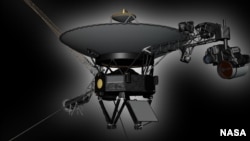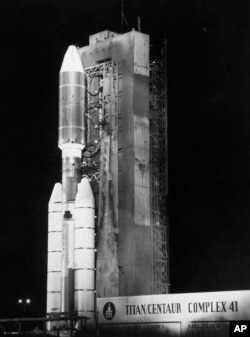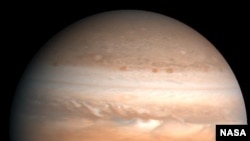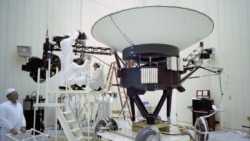The American space agency NASA is celebrating the longest mission in its history. The mission involves two spacecraft – Voyager 1 and Voyager 2. They launched in 1977.
NASA officials have said that when first launched, the Voyager mission was expected to last five years. But both Voyager 1 and Voyager 2 are still traveling and collecting valuable scientific data from the farthest reaches of space.
The two spacecraft launched within weeks of each other in the summer of 1977. Last week marked the 45th anniversary of the launch of Voyager 1, on September 5 of that year.
Voyager 1 and Voyager 2 were designed to explore Jupiter and Saturn. Both spacecraft successfully carried out studies of those planets.
Later, Voyager 2 completed the first-ever close observations of Uranus, in 1986, and Neptune, in 1989. The fly-by trips involving the four planets became known as the Voyager “Grand Tour.”
The two spacecraft then began a new mission to explore distant areas of space. In 2013, NASA announced that Voyager 1 had crossed over the border that divides our solar system from interstellar space.
The term “interstellar” means “between stars.” Scientists say interstellar space begins where the sun's continuous flow of particles and its magnetic field stop.
NASA said Voyager 2 first entered interstellar space in 2018. The spacecraft was more than 17.7 billion kilometers from the sun at the time. Both Voyagers are the only spacecraft so far to explore interstellar space.
The two explorers have studied how the interstellar medium interacts with the solar wind – the continuous flow of charged particles released by the sun. They have also provided data about the heliosphere, a kind of protective bubble around our solar system.
The heliosphere is created by the solar wind and is shaped and changed by interstellar conditions. The actual border of the solar system – the place where solar wind ends and interstellar space begins – is called the heliopause.
NASA says the Voyager spacecraft have provided researchers with new information about interstellar space. For example, they discovered that cosmic rays are about three times more intense outside the heliopause than deep inside the heliosphere.
Scientists have combined Voyager observations with data from newer missions “to get a more complete picture of our sun and how the heliosphere interacts with interstellar space,” NASA said.
Last year, scientists reported that Voyager 1 had recorded a “humming” noise linked to waves discovered in small amounts of gas found in the near-emptiness of interstellar space.
Nicola Fox is the director of the Heliophysics Division at NASA Headquarters in Washington D.C. She said in a statement the Voyagers’ work has provided valuable information about the sun, as well as the sun’s influence throughout the whole solar system. “Over the last 45 years, the Voyager missions have been integral in providing this knowledge and have helped change our understanding of the sun and its influence in ways no other spacecraft can,” Fox added.
Each Voyager is powered by a thermoelectric power system containing plutonium. As the plutonium breaks down, the heat output drops and the Voyagers lose electricity. To make up for this, NASA said the team turned off all non-necessary systems and some once considered necessary. These include heaters that protect the still-operating instruments from the extreme cold of space.
But the space agency reports that all five of the instruments that had their heaters turned off since 2019 are still working. NASA scientists continue to wonder how the Voyagers continue to operate in temperatures which are far lower than they were designed for.
Linda Spilker is the Voyager mission’s deputy project scientist at NASA’s Jet Propulsion Laboratory in California. She said that even after 45 continuous years of exploring space, Voyager 1 and Voyager 2 are still “providing humanity with observations of uncharted territory.”
I’m Bryan Lynn.
Bryan Lynn wrote this story for VOA Learning English, based on reports from NASA, The Associated Press and Reuters.
____________________________________________________
Words in This Story
mission – n. an important task, usually involving travel
bubble –n. a ball of gas enclosed by another material
cosmic ray – n. high-energy particles that move through space at nearly the speed of light
integral – adj. very notable or important
thermoelectric – n. producing electricity by a difference of temperatures
uncharted – adj. completely new and not previously experienced before
What do you think of this story? We want to hear from you. We have a new comment system. Here is how it works:
- 1. Write your comment in the box.
- 2. Under the box, you can see four images for social media accounts. They are for Disqus, Facebook, Twitter and Google.
- 3. Click on one image and a box appears. Enter the login for your social media account. Or you may create one on the Disqus system. It is the blue circle with “D” on it. It is free.
Each time you return to comment on the Learning English site, you can use your account and see your comments and replies to them. Our comment policy is here.













Forum